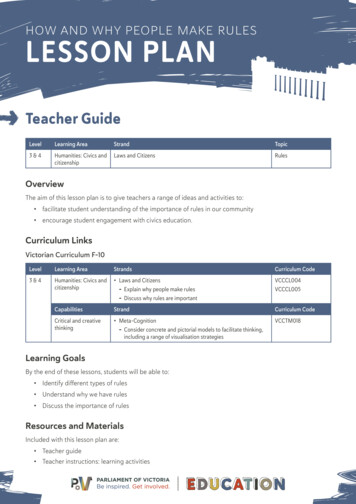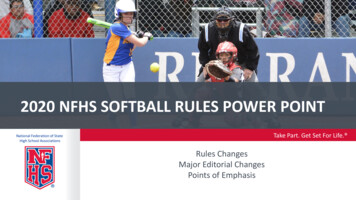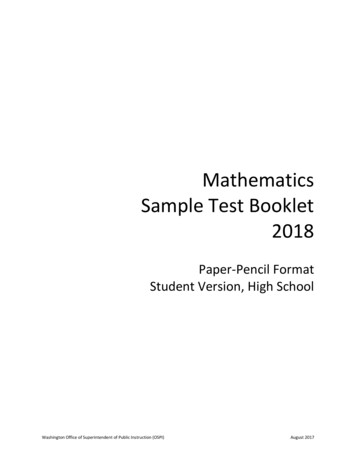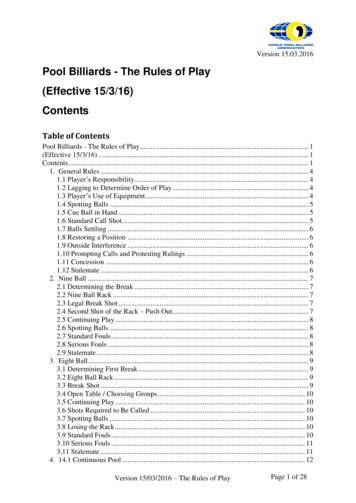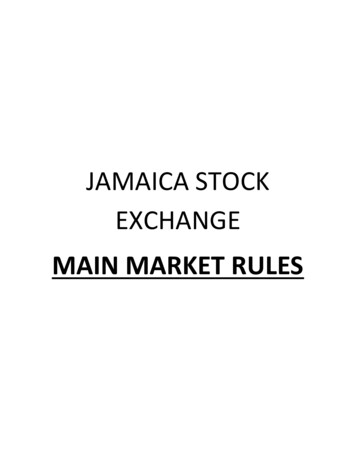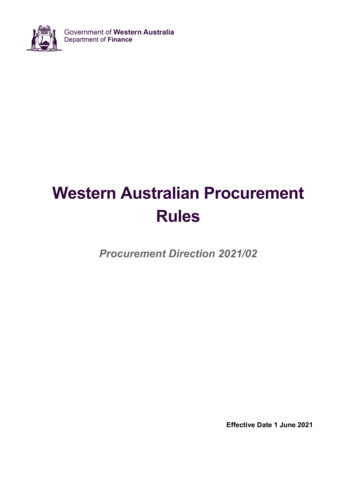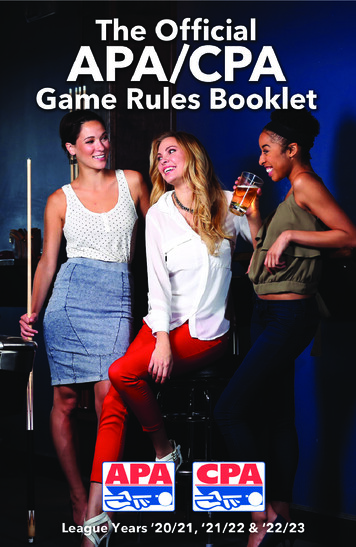
Transcription
a1
CONTENTSGeneral Description . . . . . . . . . . . . . . . . . . . . . . . . . . . 1Lagging . . . . . . . . . . . . . . . . . . . . . . . . . . . . . . . . . . . . . 2Racking. . . . . . . . . . . . . . . . . . . . . . . . . . . . . . . . . . . . . . 3Breaking. . . . . . . . . . . . . . . . . . . . . . . . . . . . . . . . . . . . . 4After The Break. . . . . . . . . . . . . . . . . . . . . . . . . . . . . . . 6Shooting The Wrong Balls. . . . . . . . . . . . . . . . . . . . . . 8Combination Shots. . . . . . . . . . . . . . . . . . . . . . . . . . . . 9Pocketed Balls. . . . . . . . . . . . . . . . . . . . . . . . . . . . . . . 10Balls On The Floor . . . . . . . . . . . . . . . . . . . . . . . . . . . 10Accidentally Moved Balls. . . . . . . . . . . . . . . . . . . . . . 11Close Hits. . . . . . . . . . . . . . . . . . . . . . . . . . . . . . . . . . . 12One Foot On The Floor . . . . . . . . . . . . . . . . . . . . . . . 13Marking The Table . . . . . . . . . . . . . . . . . . . . . . . . . . . 14Stalemates. . . . . . . . . . . . . . . . . . . . . . . . . . . . . . . . . . . 14Frozen Balls. . . . . . . . . . . . . . . . . . . . . . . . . . . . . . . . . 15Fouls. . . . . . . . . . . . . . . . . . . . . . . . . . . . . . . . . . . . . . . 17How To Win A Game . . . . . . . . . . . . . . . . . . . . . . . . 20 Copyright 2020, American Poolplayers Association, Inc.
GAME RULESGENERAL DESCRIPTIONIt is impossible to cover every situation with rules.Common sense must prevail. Play within the Spirit ofthe Rules, as well as the written rule. Teams that try togain an advantage by creating their own interpretationof rules are subject to sportsmanship violations. Win atthe table and not from the chair.8-Ball is played with a cue ball and a rack of 15 objectballs. The primary purpose of this game is for oneplayer to pocket the solid balls numbered from 1 to 7or the striped balls numbered from 9 to 15, and thenpocket the 8-ball before their opponent. Each player’scategory of balls is determined when the first playerlegally pockets a ball. For example, if the first ballpocketed in the game is the 3-ball, then that playermust pocket the rest of the balls numbered 1 to 7 whilethe opposing player attempts to pocket all the ballsnumbered 9 to 15. The turn passes from one player tothe next whenever the shooter fails to pocket a ball oftheir category or fouls. A player legally pocketing a ballof their category must continue to shoot.The player who pockets their entire category of ballsfirst, and then legally pockets the 8-ball, is the winnerof the game. In League play, the 8-ball must bepocketed in a marked pocket.1NOTE: In Masters Divisions, players have the optionof calling, rather than marking, the 8-ball pocket.
9-Ball is played with a cue ball and nine object ballsnumbered 1 through 9. It is a rotation game, meaningthe balls are shot in numerical order. The shootermust strike the cue ball into the lowest numbered ballon the table first. The game is over when the 9-ballis legally pocketed. A player retains their turn at thetable as long as they strike the lowest numbered ballfirst, and legally pocket a ball. The shooter need notpocket the lowest numbered ball to continue shooting.For example, the shooter may strike the 1-ball intothe 4-ball (a combination shot) thus pocketing the4-ball and continue their turn at the table. On theirnext shot, the 1-ball must again be struck first. If theshooter shoots the lowest numbered ball into the 9-balland pockets the 9-ball, the game is over. In Leagueplay, balls 1 through 8 are worth one point each whenpocketed and the 9-ball is worth two points.NOTE: In Masters Divisions, 9-Ball is not played byball count/points. Each individual game is won whenthe shooter legally pockets the 9-ball.1. LAGGINGPlayers lag at approximately the same time to see whowins the first break. The ball that stops closest to thehead rail wins. It is permissible to strike the headrail. If the lagged balls make contact with each other,both players fail to strike the foot rail during the lag,or a ball stops in the jaw of a pocket, re-lag. Failureto strike the foot rail, or striking a side rail, or any2
pocket, results in loss of lag. Players are discouragedfrom using the cue ball during the lag. Insisting uponlagging with the cue ball is considered a sportsmanshipviolation and should be reported to Local LeagueManagement. The winner of the lag breaks in the firstgame; from that point on, the winner of each rackbreaks in the next game. Please note the following: In Masters Divisions, the winner of the lag willhave choice of format or the break. Once theformat has been chosen, the entire set of thatformat must be completed before moving to theother format. In Doubles Divisions, the lag does not count aspart of the player rotation.2. RACKINGAll balls should be frozen (touching) as tightly aspossible. Balls are racked by the non-breaking player,with the head (front) ball on the foot spot. Thebreaking player may request and receive a rerack. Theloser of the lag, and/or the loser of any subsequentgame, racks for the opponent. In each format, the ballplacement in the rack is as follows: 8-Ball - All 15 balls are racked in a triangle,with the 8-ball in the center. The remaining ballscan be placed in any order. 9-Ball - The balls numbered 1 through 9 areracked in a diamond shape. The 1-ball is placedat the front of the diamond, the 9-ball in the3
center. The remaining object balls can be placedin any order. When using coin-operated tables,teams have the option to substitute any unusedballs (10-ball to 15-ball) for pocketed ballsfollowing a short game; this will save both teamsmoney during League night. The breaker can askfor the lowest available nine balls to be used ineach game.Example: If the 3-ball and 9-ball are made onthe break (because a 9-on-the-Snap is a win,unless you scratch), you can use the 10-ball and11-ball in the next rack. The object ball sequencein the next game would be 1, 2, 4, 5, 6, 7, 8,10 and 11. The 11-ball, in effect, is the “9-ball”(last ball) in this game. Do not use the 10-ballto replace the 3-ball, as this can be confusing.Shoot the balls in numerical order.3. BREAKINGThe rack must be struck before a foul can occur.A player must break from behind the head string forthe break to be considered legal; in addition, at leastfour object balls must be driven to the rails or a ballmust be pocketed. The cue ball may not be shot into arail before hitting the rack.NOTE: A player who is physically unable to breakdue to a medical condition may pass the break tothe opponent, but only with prior approval fromLocal League Management. Such occurrences4
should be marked as a Defensive Shot and an inningwhere appropriate. Players are not allowed to have ateammate break for them.The cue ball’s point of contact with the table is used todetermine if it is behind the head string, also referredto as being in. To make this determination simplycompare the head string, an imaginary line connectingthe two diamonds that are second from the head rail,to the cue ball’s point of contact. A ball that is deadcenter on the head string is considered out, or notbehind the head string.The cue ball must make contact with the rack asfollows to be considered legal: 8-Ball - The head ball or the second row of ballsmust be struck first. Failure to strike the headball or second row of balls does not result ina foul. 9-Ball - The 1-ball must be struck first. Failureto strike the 1-ball first does not result in a foul.If the rack is struck, but the break does not qualify aslegal, the balls are reracked by the non-breaking playerand rebroken by the same breaking player.If the rack is struck, but the break does not qualify aslegal and results in a scratch, the balls are rerackedand broken by the opposite player.Breaking safe or soft is not allowed. Make a note onthe scoresheet if you observe a player breaking safe or5
soft. Local League Management may issue penalties toteams and players who are not breaking hard. Breakingjust hard enough to comply with this rule is not aguarantee against penalties. Break as hard as you canwhile maintaining control.4. AFTER THE BREAKVarious circumstances can occur upon completion ofthe break. They are: A foul on a legal break will result in ball-in-handfor the opponent. No balls are pocketed; it is the opponent’s turn. An object ball is pocketed; it is still the breaker’sturn.8-Balla. If a scratch occurs on the break, the opponentreceives ball-in-hand, which must be executedfrom behind the head string, shooting at a ballthat is outside the head string. If an object ball isdead-center on the head string, or out, then it isplayable. If it is in, the ball is not playable. If thetwo players cannot agree on whether an objectball is in or out, then a third party should beconsulted. If a third party is consulted, the thirdparty’s call is final. If no agreed upon third partyis available, then a coin flip will decide the issue.To intentionally shoot at a ball that is in is asportsmanship violation to be reported to LocalLeague Management.6
NOTE: The cue ball must be in as noted abovebefore play can begin. This is not a foul; nopenalty may be assessed. It is up to the opponentto check to be sure the cue ball is in before itis shot. If the cue ball is out, the shooter mustreadjust the cue ball to a position behind thehead string.b. If the 8-ball is pocketed on the break, it is a winunless the player fouls the cue ball, in which caseit is a loss.c. If one or more object balls from one categoryare pocketed on the break, that becomes theshooter’s category of balls.d. If balls from each category are pocketed on thebreak (for example, two solids and one stripe), itis still an open table.The breaker has the option to shoot any ballexcept the 8-ball (which would be a foul); any ballpocketed without fouling counts. If the shootermakes one ball of each category on their secondshot, the table remains open; a miss or foul onthe second shot results in an open table for theopponent. If the opponent then pockets a ball andfouls, it is still an open table.7NOTE: During an open table, a player canshoot a combination involving stripes and solids;the legally pocketed ball will determine theircategory of balls for the remainder of the game.The 8-ball may not be used as the first ball in acombination shot, as it is never neutral.
9-Balla. A foul on a legal break will result in ball-inhand for the opponent anywhere on the table.Pocketed balls, if any, stay down (are notspotted), except the 9-ball. Pocketed balls aremarked as dead balls on the scoresheet.b. If the 9-ball is pocketed on the break, this is awin unless the player scratches, in which case the9-ball (any other available high numbered ball isadequate) is spotted and the turn passes to theopponent. If the foot spot is occupied by anotherball, the 9-ball is placed directly behind that balland as close to the foot spot as possible.c. If one or more balls are pocketed on the break, itis still the breaker’s turn.NOTE: Push-outs are fairly standard in pro eventsand in the U.S. Amateur Championship; however,they are not allowed in APA handicapped competition.Masters Divisions are non-handicapped and followU.S. Amateur Championship rules; therefore, thepush-out is allowed, and any balls pocketed on a pushout will be spotted.5. SHOOTING THE WRONGBALLSOccasionally, a player will foul by mistakenly shootingthe wrong category of balls (in 8-Ball) or the wrongnumbered ball (in 9-Ball). The shooter may avoid afoul by asking the opponent which ball or category of8
balls they should be shooting. If asked, the opponentmust answer honestly. If the shooter hits the wrongball, a foul occurs as soon as the wrong ball is struck,regardless of whether the ball is pocketed or not.NOTE: If a foul is not called before the shooter takesa subsequent shot, and makes legal contact with aball of their actual category (in 8-Ball) or the lowestnumbered object ball on the table (in 9-Ball), it is toolate to call the foul. In addition, the following ruleswill then apply depending on the format: 8-Ball - Once a player makes legal contact withthe 8-ball, the player assumes control of thatcategory of wrongly pocketed balls and canwin the game by legally pocketing the 8-ball.In addition, if the sitting player does not calla foul before the opponent’s turn ends, andsubsequently contacts the wrong ball duringtheir turn, both players will assume the newcategory of balls for the remainder of the game. 9-Ball - Any balls pocketed prior to the foulbeing called will be marked as dead balls, exceptthe 9-ball, which will be spotted.6. COMBINATION SHOTS9Combination shots are legal, but striking the correctball first is required. 8-Ball - The 8-ball may not be contacted first.If a player does not pocket one of their balls, butpockets an opponent’s ball, they lose their turn.No pocketed ball is spotted.
9-Ball - The lowest numbered ball on the tablemust be struck first. A player is credited with allballs they legally pocket after striking the lowestnumbered ball on the table.7. POCKETED BALLSBalls must remain in a pocket to be legal. If any ball,including the cue ball, goes in a pocket, but bouncesback onto the playing surface, it is not consideredpocketed and must be played from where it lies. Theshooter does not need to designate their intended ballor pocket during the shot, except when they are legallyshooting the 8-ball.NOTE 1: Once a ball has stopped all motion, itcannot move again without outside forces affecting it.Therefore, if a ball which has been hanging in a pocketfor more than a few seconds suddenly drops, it is to beplaced back on the table where it was originally sitting.NOTE 2: If two balls become jammed in a pocketand are leaning off the edge of the slate to somedegree, they are deemed pocketed. Drop them in thepocket and resume playing unless doing so ends thegame.8. BALLS ON THE FLOORObject balls that get knocked off the playing surfacewill be spotted on the foot spot. If the foot spot istaken, the ball will be placed directly behind the foot10
spot, as close to the foot spot as possible. If two ormore balls are knocked on the floor, they are placed innumerical order with the lowest numbered ball closestto the foot spot. Spotted balls are placed frozen toone another. 8-Ball - It might occur that a player legallypockets a ball while simultaneously knockingsome other ball(s) on the floor. In this situation,it is still their turn and the ball(s) is/are notspotted until their turn ends. If the ball onthe floor is one of the shooter’s balls, then itis spotted when the shooter has pocketed allof their other balls. If it is the 8-ball that isknocked on the floor, the shooter loses the game. 9-Ball - Balls that get knocked off the playingsurface will be immediately spotted on the footspot. The 9-ball is spotted:a. Anytime it is knocked off the table otherthan when it is pocketed.b. Anytime it is pocketed and the shooterscratches or otherwise fouls.9. ACCIDENTALLY MOVED BALLS11Accidentally moved balls must be replaced, unless anyof the accidentally moved balls make contact with thecue ball. If accidentally moved balls make contactwith the cue ball, it is a ball-in-hand foul, and no ballsget replaced. If the accidental movement occurs betweenshots, the ball must be replaced by the opponentbefore the shot is taken.
If the accidental movement occurs during a shot,all balls accidentally moved must be replaced bythe opponent after the shot is over and all ballshave stopped rolling.NOTE: An object ball that is in motion and makesaccidental contact with a bridge, cue stick, etc. is notreplaced.If, during the course of the shot, another ball stops inthe position previously occupied by the accidentallymoved ball, the opponent must place the accidentallymoved ball, in a fair manner, as close as possible to itsoriginal position.10. CLOSE HITSPotential bad hit situations are usually fairly obvious.Disputes over these situations can almost always beavoided by having a third party, agreed upon by bothshooters, watch the shot. The sitting team shouldprotect itself by stopping the game prior to the shot.The shooter is required to stop if their opponent wantsthe shot watched. Once an agreed upon third partyis asked to watch the shot, the third party’s call willstand and cannot be disputed.In general, the shooter has the advantage in closehit situations. If the outside party cannot determinewhich ball was struck first, such as a simultaneoushit, the call goes to the shooter. Teams involvedin repeatedly calling bad hits without third party12
verification may be subject to a sportsmanshipviolation and may have points deducted at thediscretion of Local League Management.NOTE: If a third party is not asked to watch the hit,and the hit is disputed, the call will tend to favor theshooter.11. ONE FOOT ON THE FLOORWhen a bridge is available, at least one foot must beon the floor while shooting. Failure to keep at leastone foot on the floor is not a foul, but may result in asportsmanship violation. Local League Managementcannot guarantee the presence of a bridge, and someHost Locations do not have them. A team that carriestheir own bridge may only use it if they are willing toshare it with the opposing team since refusing to do sowould provide an unfair advantage. If a bridge is notavailable, House Rules prevail. Wheelchair players - Players shooting froma wheelchair must remain seated in theirwheelchair while shooting. If a player decides toexit the wheelchair to perform a shot, they mustfully exit the chair. Players may not execute shotswhile “half-in, half-out” of a wheelchair.13NOTE: Players who have a legitimate need to usea stool, due to their height, are allowed to use one,provided they are able to move the stool by themselvesand keep both feet on the stool. Additionally, whenracking they may stand on a stool or have a teammateassist them.
12. MARKING THE TABLENo one is allowed to mark the cloth in any way,including, but not limited to, using chalk to draw aline or wetting a finger to dampen the cloth. Teamsmay be subject to sportsmanship violations for markingthe cloth. It is permissible to set a piece of chalk on thehard surface of the rail.13. STALEMATESIn the unlikely event that a game should becomestalemated, meaning that neither player can, or wantsto, make use of ball-in-hand, the balls are rerackedand the player that had the break at the start of thestalemated game breaks again. A game shall beconsidered a stalemate when both players or teamsagree. There is no minimum number of turns thatmust occur before a game is stalemated.To score a stalemated game in: 8-Ball - Put an “X” across the entire gamebox. The innings and Defensive Shots for thestalemated game do not count. 9-Ball - The game ends but the points earnedstand. The innings and Defensive Shots remainand all balls left on the table are marked asdead balls.14
14. FROZEN BALLSA frozen ball is a ball that is touching either anotherball or a rail. In order for the frozen ball rule to be ineffect, the ball must be declared “frozen” and verified assuch by the shooter and their opponent. If the playersin the match cannot agree, an agreed upon third partymay be asked to determine if a ball is frozen.Object ball frozen to a rail - To make a legal shot,after contacting a ball that is frozen to a rail, theshooter must either: Drive the cue ball to any rail after the cue balltouches the frozen ball. Drive the frozen ball to another rail or intoa pocket. Drive the frozen ball away from the rail and intoanother ball which, in turn, causes the frozenball to hit any rail or go into a pocket, or causesthe other ball to hit any rail or go into a pocket.To make a legal shot, after simultaneous contactbetween a frozen ball and the rail it is frozen to, theshooter must either: Drive the cue ball to another rail. Drive the frozen ball to another rail or intoa pocket. Drive the cue ball off the rail and into another15ball which, in turn, causes the cue ball to hit anyrail, or causes the other ball to hit any rail or gointo a pocket.
Drive the frozen ball off the rail and intoanother ball which, in turn, causes the frozenball to hit any rail, or causes the other ball to hitany rail or go into a pocket.Cue ball frozen to your own object ball - If the cueball causes the object ball to move (by exerting forceinto the frozen ball, not by breaking contact with thefrozen ball), it is considered to be contacted duringthe shot. 8-Ball - If you are shooting away from the objectball the cue ball is frozen to, in order to make alegal shot, you must contact another object ball,and then drive a ball to a rail or into a pocket.If the cue ball is frozen to the last ball of yourcategory, the cue ball must separate from theobject ball, then come back and make contactwith the ball it was originally frozen to and drivea ball to a rail or into a pocket. 9-Ball - If you are shooting away from the objectball you are frozen to, in order to make a legalshot you must contact the lowest numbered balland drive a ball to a rail or pocket a ball. If thecue ball is frozen to the next ball in the rotation,the cue ball must separate from the object ball,then come back and make contact with the ballit was frozen to, and after contact, drive a ball toa rail or into a pocket.Cue ball frozen to your opponent’s ball - You mustshoot away from the opponent’s ball. If the cue ball16
causes the opponent’s ball to move, which does notinclude breaking contact with the frozen ball, it willresult in a foul.15. FOULSIf any of the following fouls are committed, thepenalty is ball-in-hand for the opposing player. Makecertain you have ball-in-hand before you touch the cueball by confirming it with your opponent. Ball-in-handis the advantage given to a player when their opponentscratches or otherwise fouls, whereupon the player mayplace the cue ball anywhere on the playing surface.EXCEPTION: In 8-Ball, a scratch on the breakrequires the ball-in-hand to be executed from behindthe head string and contact made with a ball outsidethe head string.Even after having addressed the cue ball a playermay, if not satisfied with the placement, make furtheradjustments with their hand, cue stick or any otherreasonable piece of equipment.Only the player or the Team Captain may officially calla foul, although anyone may suggest to the player orthe Team Captain that a foul should be called.NOTE: A foul that is not called when it occurs cannotbe called once the next shot has been taken.17
These are the only fouls resulting in ball-in-hand. Allother violations are sportsmanship violations. The ballin-hand fouls are:a. If the cue ball goes in a pocket, on the floor, orotherwise ends up off the playing surface.b. Failure to hit the correct ball first.c. Failure to hit a rail or pocket a ball after contact.A rail must be struck by either the cue ball or anyother ball after the cue ball contacts the objectball. If the ball bounces back onto the playingsurface, it is considered to have struck a rail.d. If, after making contact with a ball that is frozento a rail, the shooter fails to: Drive the cue ball to any rail after the cue balltouches the frozen ball. Drive the frozen ball to another rail or intoa pocket. Drive the frozen ball away from the rail andinto another ball which, in turn, causes thefrozen ball to hit any rail or go into a pocket,or causes the other ball to hit any rail or gointo a pocket.If, after making simultaneous contact between afrozen ball and the rail it is frozen to, the shooterfails to: Drive the cue ball to another rail. Drive the frozen ball to another rail or intoa pocket.18
Drive the cue ball off the rail and into anotherball which, in turn, causes the cue ball to hitany rail, or causes the other ball to hit any railor go into a pocket. Drive the frozen ball off the rail and intoanother ball which, in turn, causes the frozenball to hit any rail, or causes the other ball tohit any rail or go into a pocket.e. Intentionally jumping a cue ball over another ballby scooping it into the air.f. Receiving advice regarding game strategy from afellow player, other than your designated coach,during a time-out.g. Touching or causing the cue ball to move, outsideof a ball-in-hand situation.h. Altering the course of a moving cue ball,including a double-hit.i. Anytime the cue ball makes contact with anaccidentally moved ball.j. The cue ball does not touch any object ball duringthe course of a shot.k. Touching another ball on the table, while placingor adjusting the position of the cue ball, during aball-in-hand.DOUBLES ONLY - Shooting Out Of Rotation.Once a team has shot out of rotation, the foul hasoccurred. If the sitting team does not call the foulbefore the next shot is taken, they do not receive19
ball-in-hand and the team that shot out of rotationwill assume the new rotation for the remainder ofthe match. 8-Ball - If the 8-ball is pocketed during the shot,it is loss of game, if called. 9-Ball - If the 9-ball is pocketed during the shot,the 9-ball is spotted and the opponents receiveball-in-hand.16. HOW TO WIN A GAME8-BALLa. You pocket all the balls of your category andlegally pocket the 8-ball in a properly markedpocket.b. Your opponent pockets the 8-ball out-of-turn orknocks it on the floor.c. Your opponent pockets the 8-ball in the wrongpocket.d. Your opponent fails to properly mark the pocketwhere the 8-ball is pocketed, and you call lossof game.e. Your opponent fouls the cue ball and pocketsthe 8-ball.f. Your opponent alters the course of the 8-ball orthe cue ball in an attempt to prevent a loss.g. Your opponent scratches or knocks the cue balloff the table when playing the 8-ball.20
NOTE 1: If your opponent is shooting at the 8-balland misses it altogether, commonly referred to as atable scratch, they have fouled and you receive ball-inhand. You do not win because of this foul.NOTE 2: You may not play the 8-ball at the same timeyou play the last ball of your category. The 8-ball mustbe pocketed through a separate shot. If you pocket the8-ball at the same time you pocket the last ball of yourcategory, you lose the game.Marking the pocketa. A coaster or some other reasonable marker mustbe placed next to the shooter’s intended pocket.b. Marking the pocket with chalk is notrecommended.c. Both players may use the same marker.d. Only one marker should remain on the table ata time.e. If the marker is already at the intended pocketfrom a previous attempt or game, it is notnecessary to touch it, pick it up or reposition it.NOTE: Making contact with a marker is not a foul. Ifa pocket marker is placed on the rail and accidentallyinterferes with the shot (either in a positive or negativeway), the shot stands.9-BALLYou legally pocket the 9-ball.21
22Revised 1/20
and pockets the 9-ball, the game is over . In League play, balls 1 through 8 are worth one point each when pocketed and the 9-ball is worth two points . NOTE: In Masters Divisions, 9-Ball is not played by ball count/points . Each individual game is won when the shooter legally pockets the 9-ball . 1. LAGGING


